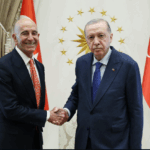Summary by Geopolist | Istanbul Center for Geopolitics
The article from the Lowy Institute discusses the shortfall in international support for Southeast Asia’s energy transition. Despite promises of substantial climate finance from Western governments, actual funding has been insufficient, with investments in renewable energy projects significantly declining. Challenges include inadequate funding, slow project implementation, and political obstacles. The region’s energy demand is rising, necessitating a substantial increase in climate finance to achieve emission reduction targets and support the global net zero transition. More coordinated and ambitious efforts from international partners are urgently needed. Read more here.
One of Southeast Asia’s most severe heat waves may have just passed, but scientists have made clear similar events are only going to become more frequent. It’s an important reminder, if one was needed, that Southeast Asian nations are some of the most heavily exposed to the ravages of climate change. Yet the region is also a rapidly growing source of carbon emissions, now consuming more coal each year than either the United States or the European Union.
In response, Western governments have made big promises to provide substantial publicly-funded climate finance to the region – recognising not only their responsibility but also the vital importance of Southeast Asia to the world’s net zero hopes.
Unfortunately, our research at the Lowy Institute shows that these big promises have so far failed to translate into much action on the ground. In fact, things have been going backwards.
The International Energy Agency estimates that clean energy investment in Southeast Asia needs to quadruple to US$130 billion by 2030. Investment needs for climate adaptation are similarly substantial.
Yet, our research finds that climate-related funding from international partners – including foreign governments such as the United States, Japan, and Australia as well as multilateral institutions like the World Bank – was less than US$11 billion in 2022, with only a small proportion going to projects fully dedicated to combating climate change as opposed to ones where climate-related issues are only an element within projects targeting other purposes like transport connectivity or better governance.
Shockingly, only about US$830 million went to renewable energy projects such as solar, wind, hydro and geothermal power, down by more than half compared to US$1.7 billion in 2018. reflecting both inadequate new funding but also difficulties in launching new projects.
Looking ahead, it is far from clear that any ramp up in international climate finance is around the corner.
Take the new Just Energy Partnership (JETP) deals, so far signed between Vietnam and Indonesia together with a group of international partners, principally G7 governments.
The JETPs promise big dollars, with about US$20 billion for Indonesia and US$15 billion for Vietnam split roughly equally between public funding commitments and targeted funds to be raised from private investors.
Signed in late 2022, it is still early days for both programs. But the early signs have been worrying, with progress proving difficult in both cases and little by way of concrete results expected in the near term due to a myriad of issues. These include political obstacles, slow decision making, disagreements over precise decarbonisation plans, problems structuring viable deals especially for the early retirement of existing coal plants, and the simple fact that the financial terms offered under the JETPs are not concessional enough with only a small amount in the form of grants.
The expansion of JETP arrangements to other countries consequently seems to have been put on the backburner.
Notably, the JETPs were at least partly conceived as a response from Western governments to China’s growing influence through its infrastructure megaprojects under the Belt and Road Initiative. Indeed, China has been the largest single source of international renewable energy finance to Southeast Asia, channelling an average of $800 million annually since 2015 via its government-controlled policy banks.
Unfortunately, however, there is not much for China to crow about here either. Most of China’s renewable energy support has gone into hydropower dams along the Mekong river, especially in Laos where this has caused considerable damage to local eco-systems and communities, imperilled the livelihoods of fishermen and farmers, and resulted in a mass of unsustainable debt. China’s renewable energy support to the region has also been trending down sharply in recent years, dropping from nearly $1 billion in 2015 to just $270 million in 2022.
Southeast Asia still needs far more energy. Energy demand is expected to rise by at least a third by 2050. Asean nations have pledged significant emission cuts and net-zero targets. But renewables currently make up only 15 per cent of the region’s power generation. In Indonesia, Malaysia, and Philippines, coal remains king. Squaring this circle will require a big lift in international climate finance.
Later this year world leaders are expected to set a new target for global climate finance at the upcoming COP29 Summit to be held in Azerbaijan. The so called New Collective Quantified Goal will build on the current target of US$100 billion per year globally. The old target, which was supposed to be reached by 2020, was widely acknowledged as well below sufficient. Yet, donor governments still struggled to meet the goal, only managing to do so two years behind schedule.
Aside from how much ambition the new global climate finance target will reflect, another key question is whether China will participate as a contributor. Western governments like the United States and Australia are pushing for this. But China has been reluctant to join in.
Bringing China into the global climate finance framework however makes a lot of sense. China already provides a lot of climate finance but there is a need for this to be more transparent, provided on better terms, and come with higher project due diligence.
There is no escaping however the need for Western governments to do far more. That will be difficult amid domestic elections, cost of living pressures, and tight national budgets coming out of the pandemic.
But this is a failure not merely of the responsibility of rich and high emitting countries to adequately support developing countries with decarbonisation and adaptation. Southeast Asia’s transition to clean energy is both a regional imperative and absolutely vital to the global net zero transition.
This is the critical decade for stabilising the climate. The international community needs to do vastly more, and fast.
Source: Lowy Institute







